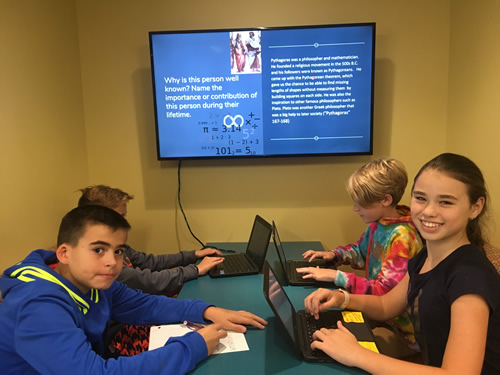After one year as library media specialist and three years teaching English, I’ve learned some of the ins and outs of teaching research inside and beyond the English classroom.
1. Start them young
There are so many skills that students must synthesize to engage in successful research. Students need to locate reliable sources, evaluate the effectiveness of said reliable sources to answer a teacher- or student-driven research question, integrate the research from various sources in a way that makes sense for the audience, and properly cite the sources they’ve used while maintaining a specific format. For these reasons, I urge you to introduce students to research endeavors as early as possible. Last year, we introduced our fourth graders to Gale’s Kids InfoBits, allowing them to explore any topic of their choice. Starting our students off early will ensure they are building the difficult research skills over time, thus improving their confidence in the process each year of exposure.
2. Encourage collaboration and communication
In general, students find comfort in tackling difficult assignments in small groups. As research tasks fall into the third and fourth depth of knowledge levels, students will go into the challenging tasks with more confidence if they’re working in a group. As many of our schools transition to a 1:1 model for technology, it becomes easier and easier to collaborate on various school projects, research included. In many classes across the curriculum, our students are using shared Google Documents to collaborate in real time on or off campus as they conduct, integrate, and revise research projects. If the research task concludes with a presentation, our students collaborate using a shared Google Slides presentation to prepare to share their findings with their peers or a larger audience.
3. Ditch the boring research report format
The 1:1 initiative in our district has allowed our staff to assign meaningful research assignments that result in our students sharing their research finding in various ways. Our students do not submit a typed research report and call the assignment done. Students present their research in a variety of ways including presentations for their peers, presentations for large-group audiences, and debate-style presentations in front of a teacher panel. Students use various tools to present their findings including Google Slides, Google Sites, Prezi, Canva, and videos. By engaging in an assortment of research experiences, our students gain a range of presentation skills as they continue to refine their research and writing skills.
4. Promote quality resources
Today’s students are accustomed to having all of the information they need with a quick Google search. However, as we teach research skills across the curriculum, students realize that they need to spend ample time evaluating those non-academic sources for accuracy, timeliness, and reliability. Because our students are so used to finding the information they need to complete a task within minutes, they are happy to take advantage of our library databases including Ebscohost, JSTOR, and Gale products. Students know they can trust the information from the sources, so they can skip right to the process of evaluating the information for its effectiveness in answering their research question[s]. Students also appreciate the citation features on the library databases provided, as they do not have to manually create and format citations from the content they come across from a Google Search.
5. Introduce research across the curriculum
Historically, research assignments were most likely to be assigned in English and history classes. Adding elements of the research process across the curriculum has helped our students feel more comfortable with research, specifically citation expectations. The more exposure our students have to these expectations, the more opportunities they have to receive feedback and make meaning in the process. At the end of the 2017-2018 school year, I collaborated with our choir teacher to plan research-driven lessons after the final choral concert to replace content the teacher believed was less meaningful for the students. Students used the same databases they use for other classes including Kids InfoBits and ebooks from the Gale Virtual Reference Library. Students prepared to debate against each other in hopes of convincing a panel of teachers and administrators that a musical career of their choice was more appealing than the other career featured in their debate.
6. Participate in active research
Nearly every student in our district participates in an extensive active research project. As a student teacher, my mentor Dr. Shannon Beach introduced me to the wonderful world of active research in the high school language arts classroom. All of our 10th-grade honors students generate a research question and work in small groups to answer that question through an extensive literature review and two to three methods of their own. Providing our students with the opportunity to conduct active research on a topic they choose and make a difference in their community has inspired many students in our district. A student in my language arts class who completed her project in 2015-2016 used her results to launch a school organization inspired by Best Buddies International. This has evolved into one of the most popular clubs in the high school.
In sum, I urge teachers and librarians to add research experiences across the curriculum in as many grade levels as possible, provide student choice in those experiences, and vary assessment formats to keep the process as fresh as possible.
- Harnessing generative AI to revolutionize educator growth - January 17, 2025
- The FAFSA is finally easier–but that’s still not enough - January 17, 2025
- 6 tips to help your school unlock the most value from AI - January 15, 2025

